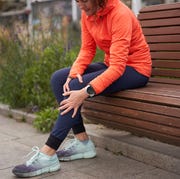Laura Kennelly had been running for several years before the pain hit. Two days after finishing her first marathon, she went off with her regular running group for an easy 5-miler. But after 2 miles, the outside of her leg began to hurt—big-time. “My leg just blew out. I stopped running and could barely walk,” she recalls. “I hobbled home in pain.”
Kennelly, a writer from Berea, Ohio, was suffering from iliotibial band syndrome, one of the most common overuse injuries among runners. Because the most notable symptom typically is swelling and pain on the outside of the knee, many runners mistakenly think they have a knee injury.
But it’s not the knee, it’s the ligament that runs down the outside of the thigh from the hip to the shin. “When the band comes near the knee, it becomes narrow, and rubbing can occur between the band and the bone. This causes inflammation,” says Freddie H. Fu, M.D., a Pittsburgh orthopedic surgeon and chairman of the board of the Pittsburgh Marathon.
More From Runner's World

ITB syndrome can result from any activity that causes the leg to turn inward repeatedly. This can include wearing worn-out shoes, running downhill or on banked surfaces, running too many track workouts in the same direction, or simply running too many miles. Unlike many overuse injuries, however, ITB pain afflicts seasoned runners almost as much as beginners.
“Forty percent of the runners we see for ITB syndrome have been running 5 or more years,” says John Pagliano, D.P.M., a sports-medicine podiatrist in Long Beach, California, and a onetime 2:26 marathoner. “That’s quite a high number. About 50 percent of them are running between 20 and 40 miles a week.
“Also ITB syndrome is much more common in women," Dr. Pagliano notes. “Why? It could be the way some women’s hips tilt, which can cause their knees to turn in.”
Some experts believe that the incidence of ITB syndrome has increased among all runners in recent years, although the reasons aren’t clear. “It could be because so many runners have ramped up their mileage for marathons before they’re ready to handle the distance,” says Stephen Pribut, D.P.M., a Washington, D.C., sports podiatrist.
Dr. Pagliano describes most runners with ITB pain as “Type A’s.” “They run high mileage,” he says. “They’re not willing to back off, and they are willing to run through pain.”
How can you tell if you have ITB syndrome? “The best way is to bend your knee at a 45-degree angle. If you have an ITB problem, you’ll feel pain on the outside of the knee,” says Dr. Fu. “Sometimes an MRI can confirm it. An X-ray is usually negative, but an MRI can show a partial thickening of the band—which results from inflammation.”
Here are some steps you can take to prevent ITB syndrome:
- Most importantly, always decrease your mileage or take a few days off if you feel pain on the outside of your knee.
- Walk a quarter- to half-mile before you start your runs.
- Make sure your shoes aren’t worn along the outside of the sole. If they are, replace them.
- Run in the middle of the road where it’s flat. (To do this safely, you’ll need to find roads with little or no traffic and excellent visibility.)
- Don’t run on concrete surfaces.
- When running on a track, change directions repeatedly.
- Schedule an evaluation by a podiatrist to see if you need orthotics.
- Avoid doing any type of squats.
Once you notice ITB pain, the best way to get rid of it for good is to rest immediately. That means fewer miles, or no running at all.
“In the majority of runners—85 percent—once they rest, the pain doesn’t come back,” Dr. Pagliano says. “But I’m not talking about the guy who finally decides to rest after feeling pain for 6 months during 90-mile weeks. You have to rest immediately.”
While you’re backing off on your mileage, you can cross-train. Swimming, pool running, cycling, and rowing are all fine. Stair-climbing is not, because it is too much like running.
Side stretches will also help, as will ice or heat, ultrasound, or electrical stimulation with topical cortisone. This last method is useful “particularly in the acute phase,” says Dr. Fu.
If you don’t give yourself a break from running, ITB syndrome can become chronic. “Then you’ll need to run fewer miles and give up marathons,” says Dr. Fu.
If your ITB problem doesn’t get better after several weeks, seek help from a sports-medicine professional. You may need a cortisone injection to break up scar tissue and help speed healing. But cortisone presents its own risks, as it can weaken ligaments and tendons. Consider cortisone injections as a “second-to-last resort,” Dr. Pagliano says.
Your last resort is surgery. “Once you’ve tried everything else, and nothing helps, we can surgically release the IT band,” Dr. Fu says. Adds Dr. Pagliano: “But surgery makes your knee a little floppier, and patients are never happy with it.”
As Laura Kennelly reports, “I’ve had other injuries since—including fractured bones in my foot—but none of them took as long to heal or still troubles me as much as that ITB strain. I know now that I have to respect that weakness in my leg, and back off when it acts up.”




